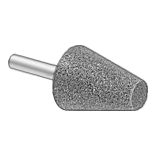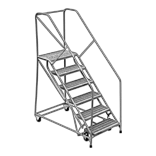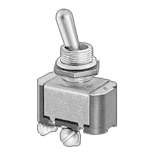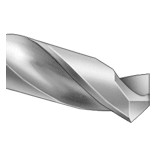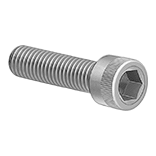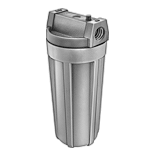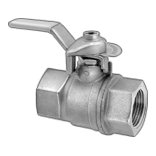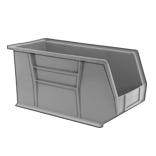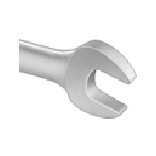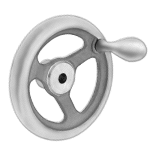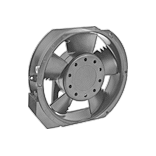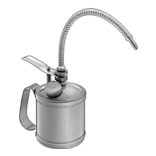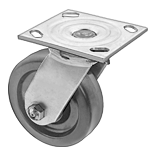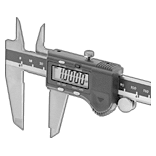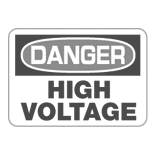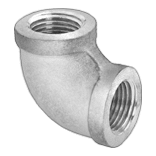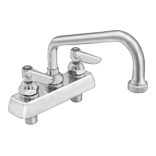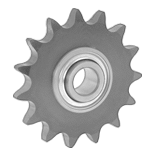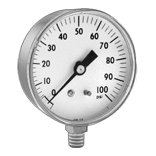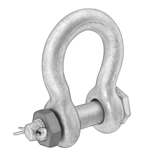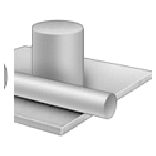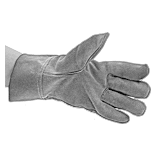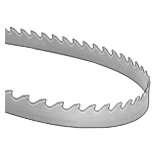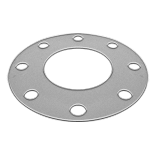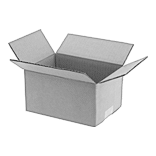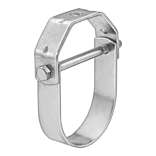Choosing a Proximity Switch
More
Rotatable DC Metallic-Object Proximity Switches
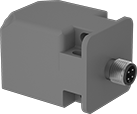
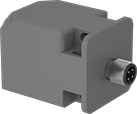


Micro
M12 Plug

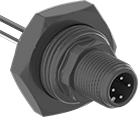
Turn the face on these switches to sense metallic objects from the front, sides, top, or bottom. They’re a good replacement for limit switches with actuators that often break when hit. Also known as inductive proximity switches, they detect objects even if they’re covered by water, oil, dirt, or a surface finish. They’re often used in conveyor and bin filling systems, refineries, and mills. Sensing distance is based on the type of material being sensed; the distance listed is for mild steel. LED status indicators on the corners mean you can check your switch from any angle. All switches meet American, Canadian, and European safety standards.
You can send PNP or NPN signals from these switches to programmable logic controllers (PLCs). Use Testers for Proximity and Photoelectric Switches to determine the signal output of a switch you’re replacing.
Flush switches, also known as embeddable and shielded switches, are more accurate than projecting switches at close range. They also won’t cause interference when mounted close together. The sensor face mounts evenly with any material, including metal.
Projecting switches, also called non-embeddable and unshielded switches, sense objects farther away than flush switches. But, they require the area around the sensor to be free of metal.
Switches with a 4-pole micro M12 plug connect to cables with a socket (sold separately), so you can quickly connect and disconnect them. To view switch wiring diagrams, select a part number and click Product Detail. Attach switches with screw terminals to optional M12 connectors with a receptacle to convert them to a standard 4-pole M12 plug.
All switches seal out dust and stand up to some submersion. IP69- and IP69K-rated switches also handle high-pressure washdowns.
For technical drawings and 3-D models, click on a part number.
Switches | Cables with Socket | Receptacles | |||||||||||||
|---|---|---|---|---|---|---|---|---|---|---|---|---|---|---|---|
| Switch Starting Position | Number of Sensing Positions | Maximum Sensing Distance, mm | Signal Output Type | Input Voltage | Lg., mm | Wd., mm | Ht., mm | Circuit Protection | Temp. Range, °F | Each | Each | Each | |||
Plastic Housing with Plastic Face (IP68 and IP69)—200mA Current Output | |||||||||||||||
Flush with 4-Pole Micro M12 Plug | |||||||||||||||
| 1 Off (Normally Open) | 5 | 30 | PNP | 10V DC-30V DC | 67 | 40 | 40 | Reverse Polarity Short Circuit | -10° to 155° | 00000000 | 0000000 | 0000000 | 000000 | 000000 | 00 |
| 1 Off (Normally Open) and 1 On (Normally Closed) | 5 | 30 | PNP | 10V DC-30V DC | 67 | 40 | 40 | Reverse Polarity Short Circuit | -10° to 155° | 00000000 | 000000 | 0000000 | 00000 | 000000 | 00 |
| 1 Off (Normally Open) and 1 On (Normally Closed) | 5 | 30 | NPN | 10V DC-30V DC | 67 | 40 | 40 | Reverse Polarity Short Circuit | -10° to 155° | 00000000 | 000000 | 0000000 | 00000 | 000000 | 00 |
Flush with M20 Screw Terminal | |||||||||||||||
| 1 Off (Normally Open) | 5 | 30 | PNP | 10V DC-30V DC | 118 | 40 | 40 | Reverse Polarity Short Circuit | -10° to 155° | 00000000 | 000000 | 0000000 | 00000 | 00000000 | 000000 |
| 1 Off (Normally Open) and 1 On (Normally Closed) | 5 | 30 | PNP | 10V DC-30V DC | 118 | 40 | 40 | Reverse Polarity Short Circuit | -10° to 155° | 00000000 | 000000 | 0000000 | 00000 | 00000000 | 00000 |
| 1 Off (Normally Open) and 1 On (Normally Closed) | 5 | 30 | NPN | 10V DC-30V DC | 118 | 40 | 40 | Reverse Polarity Short Circuit | -10° to 155° | 00000000 | 000000 | 0000000 | 00000 | 00000000 | 00000 |
Projecting with 4-Pole Micro M12 Plug | |||||||||||||||
| 1 Off (Normally Open) | 5 | 50 | PNP | 10V DC-30V DC | 67 | 40 | 40 | Reverse Polarity Short Circuit | -10° to 155° | 00000000 | 000000 | 0000000 | 00000 | 000000 | 00 |
| 1 Off (Normally Open) and 1 On (Normally Closed) | 5 | 50 | PNP | 10V DC-30V DC | 67 | 40 | 40 | Reverse Polarity Short Circuit | -10° to 155° | 00000000 | 000000 | 0000000 | 00000 | 000000 | 00 |
| 1 Off (Normally Open) and 1 On (Normally Closed) | 5 | 50 | NPN | 10V DC-30V DC | 67 | 40 | 40 | Reverse Polarity Short Circuit | -10° to 155° | 00000000 | 000000 | 0000000 | 00000 | 000000 | 00 |
Projecting with M20 Screw Terminal | |||||||||||||||
| 1 Off (Normally Open) | 5 | 50 | PNP | 10V DC-30V DC | 118 | 40 | 40 | Reverse Polarity Short Circuit | -10° to 155° | 00000000 | 000000 | 0000000 | 00000 | 00000000 | 00000 |
| 1 Off (Normally Open) and 1 On (Normally Closed) | 5 | 50 | PNP | 10V DC-30V DC | 118 | 40 | 40 | Reverse Polarity Short Circuit | -10° to 155° | 00000000 | 000000 | 0000000 | 00000 | 00000000 | 00000 |
| 1 Off (Normally Open) and 1 On (Normally Closed) | 5 | 50 | NPN | 10V DC-30V DC | 118 | 40 | 40 | Reverse Polarity Short Circuit | -10° to 155° | 00000000 | 000000 | 0000000 | 00000 | 00000000 | 00000 |
Hazardous Location Rotatable DC Metallic-Object Proximity Switches
Twist the sensor to detect metallic objects where explosive dust or gas may be present—the sensor rotates for front, side, top, or bottom sensing. These switches are UL and C-UL listed as well as ATEX and IECEx certified for hazardous locations. Their NAMUR signal produces low current and low voltage, so they won’t spark or ignite. You must connect them to a barrier (sold separately), which reduces the current and voltage that enters your hazardous area. Install the barrier in a separate location that doesn’t contain explosive gas or dust.
Because you can rotate their sensor, these switches make good replacements for limit switches with actuators that could break when hit. They’re often known as inductive proximity switches and detect objects even if they’re covered by water, oil, dirt, or a surface finish. Sensing distance is based on the type of material that’s sensed; the distance listed is for mild steel. Send signals from these switches to programmable logic controllers (PLCs) to support automated processes.
These switches have a 4-pole micro M12 plug that connects to cables with a socket (sold separately), so you can quickly connect and disconnect them. You can also check on them from any angle, thanks to LED status indicators on their corners. All are CE marked for safety.
To view switch wiring diagrams, select a part number and click Product Detail.
Flush switches, also called embeddable and shielded switches, are more accurate than projecting switches at close range. They also won’t interfere with each other’s signals when installed close together. Their sensor face mounts evenly with any material, including metal.
Projecting switches, also known as non-embeddable and unshielded switches, sense objects farther away than flush switches. But, the area around the sensor must be metal free.
IP rated, all switches seal out dust and water from high-pressure washdowns. IP67- and IP68-rated switches also withstand some submersion.
For technical drawings and 3-D models, click on a part number.
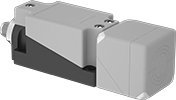
Micro
M12 Plug
| Switch Starting Position | Lg., mm | Wd., mm | Ht., mm | Max. Sensing Distance, mm | Signal Output Type | Input Voltage | Current Output | Circuit Protection | Temp. Range, °F | Environmental Rating | Each | |
Plastic Housing | ||||||||||||
|---|---|---|---|---|---|---|---|---|---|---|---|---|
Flush with 4-Pole Micro M12 Plug | ||||||||||||
| 1 On (Normally Closed) | 67 | 40 | 40 | 20 | NAMUR | 8V DC-8.5V DC | 10mA | Reverse Polarity Short Circuit | -10° to 210° | IEC Zone 0 Groups IIC, IIB, IIA NEC Class III Divisions 1, 2 IEC Zone 20 Groups IIIC, IIIB, IIIA NEC Class I Divisions 1, 2 Groups A, B, C, D NEC Class II Divisions 1, 2 Groups E, F, G IP66 IP69K | 0000000 | 0000000 |
| 1 On (Normally Closed) | 118 | 40 | 40 | 20 | NAMUR | 8V DC-8.5V DC | 10mA | Reverse Polarity Short Circuit | -10° to 210° | IEC Zone 0 Groups IIC, IIB, IIA NEC Class III Divisions 1, 2 IEC Zone 20 Groups IIIC, IIIB, IIIA NEC Class I Divisions 1, 2 Groups A, B, C, D NEC Class II Divisions 1, 2 Groups E, F, G IP67 IP69K | 00000000 | 000000 |
Projecting with 4-Pole Micro M12 Plug | ||||||||||||
| 1 On (Normally Closed) | 67 | 40 | 40 | 40 | NAMUR | 8V DC-8.5V DC | 10mA | Reverse Polarity Short Circuit | -10° to 210° | IEC Zone 0 Groups IIC, IIB, IIA NEC Class III Divisions 1, 2 IEC Zone 20 Groups IIIC, IIIB, IIIA NEC Class I Divisions 1, 2 Groups A, B, C, D NEC Class II Divisions 1, 2 Groups E, F, G IP69K | 0000000 | 000000 |
| 1 On (Normally Closed) | 118 | 40 | 40 | 40 | NAMUR | 8V DC-8.5V DC | 10mA | Reverse Polarity Short Circuit | -10° to 210° | IEC Zone 0 Groups IIC, IIB, IIA NEC Class III Divisions 1, 2 IEC Zone 20 Groups IIIC, IIIB, IIIA NEC Class I Divisions 1, 2 Groups A, B, C, D NEC Class II Divisions 1, 2 Groups E, F, G IP68 IP69K | 00000000 | 000000 |
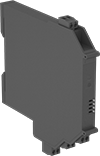
Inputs | Outputs | ||||||||||
|---|---|---|---|---|---|---|---|---|---|---|---|
| Operating Voltage | Voltage | Current | No. of | Signal Type | Current | No. of | Signal Type | Switching Frequency | Environmental Rating | Each | |
Plastic Housing | |||||||||||
| 115V AC | 10V DC | 8mA | 1 | NAMUR | 2 A @ 253 V AC 2 A @ 40 V DC 4 A @ 126 V AC | 1 | Relay | 10 Hz | Associated Apparatus for IEC Zone 0 Groups IIC, IIB, IIA Associated Apparatus for IEC Zone 20 Groups IIIC, IIIB, IIIA IP20 | 0000000 | 0000000 |
| 24V DC | 10V DC | 8mA | 1 | NAMUR | 0.05 A @ 24 V DC | 2 | Transistor | 5 kHz | Associated Apparatus for IEC Zone 0 Groups IIC, IIB, IIA Associated Apparatus for IEC Zone 20 Groups IIIC, IIIB, IIIA IP20 | 0000000 | 000000 |
Crane Safety Switches
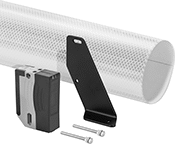
Prevent collisions while moving heavy loads with overhead bridge crane systems. These switches signal a crane to stop or slow when they detect that another crane or wall is too close. Mount the switch on your crane and the included reflector on the obstacle you want to avoid. The switch will bounce a light beam off the reflector to measure how far away it is—if it’s within the distance you’ve set, the switch triggers. These switches are also useful if you want to make sure a crane doesn’t move past a certain point. Turn the dials on the top to control the trigger distance and whether your crane stops or slows down. These switches can communicate with any crane that uses a variable frequency drive (VFD), soft starters, or contactor controls.
Mount the adhesive-backed reflector so the switch's light beam hits its center. Built to avoid signal interference from other switches, also known as crosstalk, these switches can be used next to each other without a problem. They use polarized light, so they filter out unwanted light beams and their beam stays focused on their reflector.
Rated IP67, these switches seal out dust and water, making them suitable for both indoor and outdoor applications.
Housing | |||||||||||||
|---|---|---|---|---|---|---|---|---|---|---|---|---|---|
| Sensing Distance, ft. | Input Voltage | Current Output | Transmitter/Receiver Type | Includes | Lg. | Ht. | Dp. | Material | Temp. Range, °F | Protections Provided | Specifications Met | Each | |
With Push In Terminals | |||||||||||||
Visible Light Beam (IP67) | |||||||||||||
| 3-45 | 12V AC-240V AC/12V DC-240V DC | 2,000mA | DIP Switch | Mounting Bracket, Reflector | 1" | 3 7/16" | 2 9/16" | Plastic | -40° to 140° | Signal Interference Protection | UL Listed, C-UL Listed, CCC Marked | 0000000 | 0000000 |
